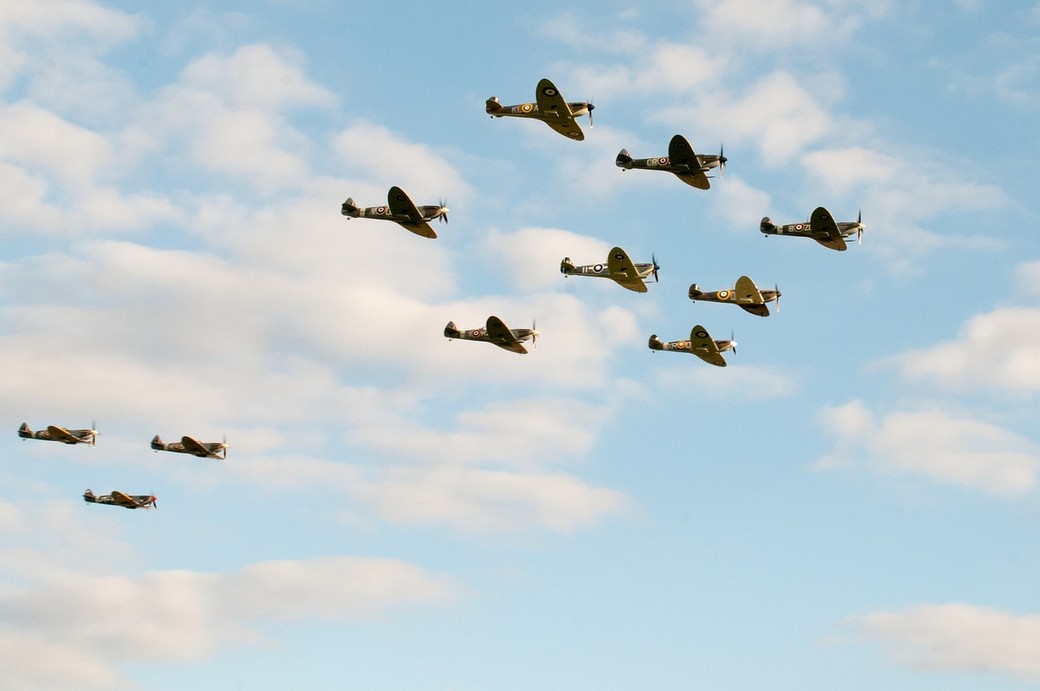
The Seventy-Fifth Anniversary of Facing the “Flying Peril”
In 1934, two decades after the outbreak of the First World War and five years before the onset of the Second, a prescient former British soldier and politician named Winston Churchill spoke about the threat posed to England by air warfare. Churchill remarked that, “The flying peril is not a peril from which one can fly. It is necessary to face it where we stand. We cannot possibly retreat. We cannot move London.” A mere six years later, in the summer and early autumn of 1940, both Churchill and England herself would face such “flying peril” in what would become the Battle of Britain. This year marks the seventy-fifth anniversary of that David and Goliath struggle.
When Germany invaded Poland in early September 1939 signaling the start of the Second World War, it was abundantly clear that British Prime Minister Neville Chamberlain’s appeasement-based foreign policy was built upon a foundation of sand. Chamberlain’s earlier — and ultimately infamous — declaration of “peace for our time” with Hitler’s Nazi Germany was not to be. As the invasion of Poland commenced, Churchill’s self-imposed exile in the political abyss ended. He was quickly appointed to the familiar position of First Lord of the Admiralty, the same title he had held throughout the early years of the First World War. By the time that Hitler’s Luftwaffe (the German air force) was preparing for its colossal air-based assault on England that summer, Prime Minister Chamberlain had resigned and Churchill had been appointed as his successor.

Launching the Battle of Britain in July of 1940, the German goal was to simultaneously overrun the Royal Air Force (RAF) — and in particular the RAF’s Fighter Command — thereby softening up Britain’s defenses and breaking the spirit of the British people prior to the staging of Hitler’s large-scale, long-planned amphibious invasion and occupation of Britain codenamed “Operation Sea Lion.” When the first squadrons of Luftwaffe aircraft warmed up and taxied for takeoff just across the English Channel in recently conquered Nazi-occupied France, the numbers seemed to be in Germany’s favor: The Luftwaffe had a nearly 2,000 aircraft advantage over what (on paper at least) was the RAF Fighter Command’s paltry inventory of some 600 combat-worthy aircraft. But a combination of factors ensured that the numbers did not remain in Hitler’s favor for long. The innovative English “Chain Home” and “Chain Home Low” radar systems for detecting air traffic crossing into English airspace, in conjunction with the vigilant individuals of the Observer Corps who tracked and relayed the coordinates of inbound Luftwaffe aircraft to the RAF once the Nazi aircraft had entered English airspace played a key role since both the Chain Home and Chain Home Low radar detection towers were all pointed outside of Britain and were unable to pivot to monitor inside English airspace. Also important was the “survival instinct-induced” industrial expansion in the production of military aircraft and equipment. And we cannot overlook the relentless efforts of the skilled pilots of the RAF — not to mention the approximately 100 Canadian pilots who flew with them.
But you wouldn’t have known this during the early stages of the battle. The Channel skirmishes of July and August allowed the Luftwaffe to wreak havoc on the supply convoys that were keeping the island nation’s economy afloat and gave German pilots the opportunity to gain a proverbial “birds eye view” of the English coastal defense mechanisms prior to striking their first aerial blow inside official British airspace. These channel skirmishes also further depleted the RAF of both men and combat-worthy aircraft. Britain was in peril.
By mid August, Hermann Goring, Hitler’s close confidant and designated commander of the Luftwaffe, decided that the time had come to carry out the true aerial assault of Britain. Knocking out the aforementioned “Chain Home” and “Chain Home Low” radar systems was to be the first step in the attack. But this proved more difficult to accomplish than was anticipated. The radar towers and their infrastructure were surprisingly robust despite repetitive aerial dive-bombing and strategic bombing attacks. In light of this setback, Goring ordered the Luftwaffe to focus its efforts on the RAF’s airfields rather than on the radar systems which — much to his frustration but to Britain’s benefit — remained close to fully operational, as did Britain’s telecommunications network. England was neither deaf nor blind in the face of the daily aerial onslaught of Luftwaffe fighters and bombers. This proved to be a fatal error for both Goring and Hitler in the air war.
In addition to attempting to neutralize the RAF’s airfields, the Luftwaffe, under Goring’s command, focused its efforts on destroying Britain’s aviation factories as well as those providing ancillary services and products to the aviation industry. And it was also during August that Goring prioritized the bomber protection (or escort) aspect of the Luftwaffe’s fighter squadrons. Rather than hunt the less advanced and outnumbered RAF fighters, many of the Luftwaffe’s quick and maneuverable fighters were relegated to bomber escort duties, a less efficient task in terms of destroying the RAF’s aircraft and the skilled pilots who flew them.
As the “scrambling” of the RAF’s venerable Hawker Hurricane fighter planes and the newer, faster Supermarine Spitfires became a more regular occurrence throughout August and into September, the ferocity of the dogfights between the RAF and the Luftwaffe increased in intensity and frequency. But the earlier manpower and equipment advantage enjoyed by the Luftwaffe began to evaporate. British radar systems working hand in hand with the telephonic relaying of Luftwaffe aircraft movements by the Observer Corps increased the efficacy of the RAF’s combat response to “the flying peril” described by Churchill so many years earlier.
Britain’s robust radar networks and the diligence of the Observer Corps were key in eliminating the element of surprise and preserving the speed of counterattack — two essential components to successful aerial dogfighting. Furthermore, Britain’s explosive production of replacement fighter aircraft during the summer of 1940 helped deplete the earlier German aerial advantage. Despite relentless aerial bombardments, the monthly production of RAF fighter aircraft increased by a staggering 60%, providing the RAF with over 1,700 new combat-worthy aircraft. By the fall of 1940, the RAF was able to replace its aircraft and pilots faster than the Luftwaffe could. The Luftwaffe’s earlier advantage in the proverbial numbers game was coming to a close.

In light of this fact, in September 1940, Goring changed the Luftwaffe’s tactics yet again. Rather than continue prioritizing the bombardment of airfields, the Luftwaffe’s daily formation bombing would focus on England’s cities and towns including, most notably, London. Beginning in early September, during a period that would come to be called the “Blitz,” London along with many of England’s other cities faced daily nightly bombardment since it had become clear to Germany that the daylight bombing runs were proving too costly. The Luftwaffe’s cumbersome, outgunned and under-armored bombers that pelted the English cities with bombs and incendiaries were generally forced to carry out their attacks without fighter escort, therefore increasing their vulnerability to the RAF’s fighters and to the English anti-aircraft batteries. The Luftwaffe’s deadly workhorse of a fighter, the fearsome but thirsty Messerschmitt Bf 109, was unable to carry enough high-octane fuel to enable it to fly from occupied France across the English Channel and as far into England as London and back again. Fuel economy was becoming one of the biggest foes for Hitler and Goring’s Luftwaffe.
With October approaching, although the air raids went deeper into the heart of England, Luftwaffe bombers were being shot out of the sky with greater ease than before, given their lack of fighter escort. The numbers were now turning to Churchill and Britain’s favor. By the second half of September, with the Luftwaffe facing repeated setbacks in their hubristic attempt to assert air superiority over Britain, Hitler delayed Operation Sea Lion, the proposed amphibious invasion of England, until at least the spring of 1941. As the bombing raids over London and many other English cities grew more sporadic and less deadly throughout October, the Battle of Britain wound down and Operation Sea Lion would ultimately never be launched.
By Halloween 1940, the Battle of Britain had officially come to a close. Britain’s RAF had held off the aerial onslaught of the German Luftwaffe. Germany was unable to gain air superiority over Britain thereby making an amphibious invasion a likely exercise in futility. The grave reality of the “flying peril” that Winston Churchill had warned of had been confronted and ultimately subdued by Churchill himself as Prime Minister, by his government, by the English people and by the men and women of the RAF.













